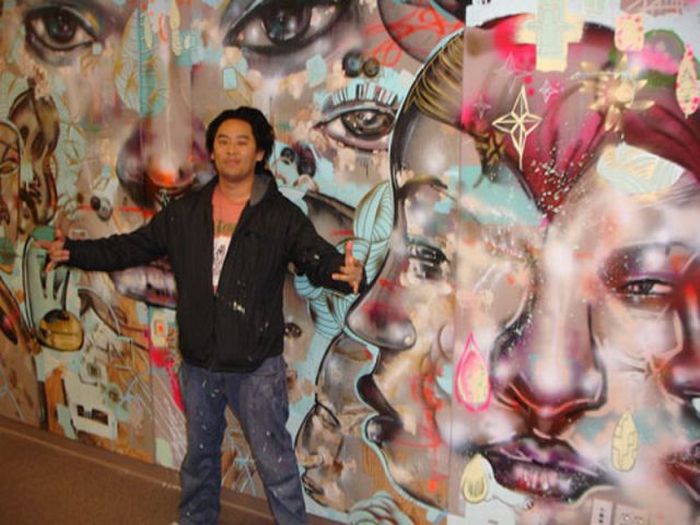Graffiti By David Choe
|
David Choe was raised in the racially diverse Koreatown neighborhood of Los Angeles, the child of Korean immigrant parents who were born-again Christians. Like many boys, his chief interests were Star Wars, G.I. Joe, Robotech and superheroes, which he drew obsessively from an early age. In his early teens, in response to having his bicycle stolen repeatedly, he began to retaliate by stealing bikes and shoplifting whenever the opportunity arose. In 1990, inspired by L.A. graffiti pioneers Mear One and Hex, he started venting his teenage anger by scrawling graffiti on bus benches, billboards and back alleys across the city. With his first can of Krylon flat black, he cited the Bible verse John 11:35, which reads "Jesus wept." Rather than writing his name over and over, he painted faces and figures, cartoony whales, and punchy philosophical messages. Though he lived in Koreatown, he went to high school in the privileged enclave of Beverly Hills, and by the time the 1992 Los Angeles riots broke out when he was 16, he had become acutely aware of the class and racial tensions that divided the city into mutually hostile territories. A proud participant in the violence and mayhem that ensued, he claims that he and his brother were the only Koreans who looted. After the six-day riot had subsided, he discovered that his parents' real estate business in Koreatown had burned to the ground, which made the next few years difficult for his family.
Immediately after graduating from high school, Choe departed on the first of many adventures, and spent the next two years freight-hopping, hitchhiking, hustling and stealing his way around the United States, Europe, the Middle East and Africa. When he returned to Los Angeles at the age of 21, he decided he needed formal training if he wanted to be a "real" artist, and enrolled in the only art school that accepted him, the California College of Arts & Crafts in Oakland. There he came under the influence of professor Barron Storey's raw, intimate, painterly style. Choe, who calls Storey "the current king of the dirty school," studied under the veteran illustrator for two years and then dropped out. All the while, he was stealing art supplies, books and food to get by, in addition to his ongoing nocturnal graffiti campaign, which eventually landed him in jail in Oakland for a week. Taking that as incentive to settle down a bit, he returned to his family home in Los Angeles, and began illustrating and writing for magazines including Hustler, Ray Gun and Vice. Around the same time, he began his ongoing relationship with the Asian pop culture store-cum-magazine Giant Robot, which has continued to be mutually beneficial to this day. He also started showing his paintings to art galleries, which exhibited little interest. In defiance, Choe hung his work in an ice cream shop called Double Rainbow which was located on the hipster promenade Melrose Avenue. That impromptu exhibition was so successful that the store held it over for two years, with Choe replenishing pieces as they sold.
Always fascinated by comics, especially the work of Jim Lee, Rob Liefeld and Todd McFarlane, Choe initially dreamed of a career as a comic book creator. In a single night in 1996, he wrote a 35-page tale of violent sexual obsession which, coupled with drawings and paintings that he created over the next couple of years, eventually became the graphic novel Slow Jams. Choe initially made about 200 copies of Slow Jams on a photocopier and gave them away at Comic-Con in 1998, hoping to interest a publisher. Later that year, he submitted Slow Jams for the Xeric Grant and was awarded $5,000 to self-publish a second, expanded edition of 1,000 which came out in 1999 with a cover price of $4. Over the next decade, Slow Jams became a cult phenomenon, and in recent years, increasingly rare copies of the graphic novel have changed hands on eBay for hundreds of dollars.
Having caught the attention of the entertainment and advertising industry with Slow Jams and that makeshift art exhibit, Choe soon found himself in great demand for commercial illustration and graphic design. Within a few years, he was successful enough to be able to turn down many offers of commercial work in order to concentrate on his own paintings and murals. Simultaneously, Choe's best friend Harry Kim began documenting his life, often living with him while videotaping his frenzied art-making, colorful personal life and intimate thoughts. Over the next 10 years, Kim would capture thousands of hours of Choe's everyday existence as an artist, footage which would eventually become the documentary Dirty Hands: The Art and Crimes of David Choe. All the while, Choe continued his obsessive traveling, from making an expedition to the jungles of the Congo to painting graffiti and murals around the globe alongside the world's greatest urban artists for the street culture brand Upper Playground.
|
|









